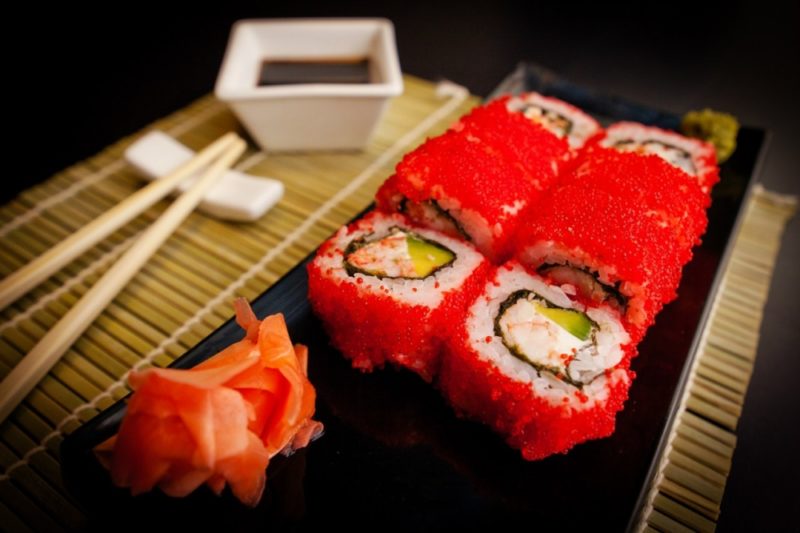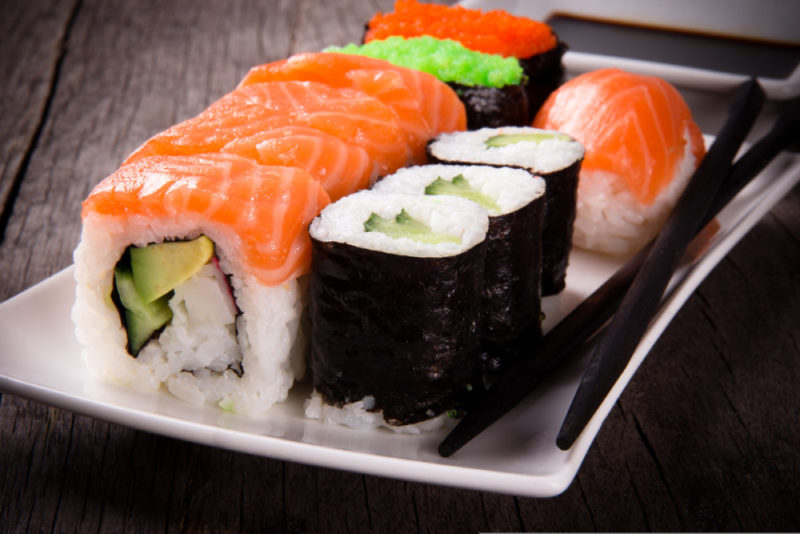Many losing weight are sure that rolls of different types are diet food that can be eaten in unlimited quantities. This is actually a false assumption. More information about calorie rolls is described in our section.
Material Content:
Chemical composition and nutritional value
In recent years, Japanese cuisine has not lost its popularity among Russian gourmets. Her lovers not only order themed dishes in cafes and restaurants, but also enjoy cooking them at home. It is difficult to unequivocally answer the question about the nutritional value of sushi and rolls. After all, there are a huge number of their varieties.
For example, you can take one of the most popular - rolls "Philadelphia".
Such a treat per 100 grams contains approximately:
- 26 g of carbohydrates;
- 7 g of protein;
- 6.5 g of fat.
Having eaten a small portion of Philadelphia, you can satisfy your daily carbohydrate requirement by about 20 percent.
When calculating the nutritional value of sushi or rolls, it is taken into account which ingredients are included in their composition. For example, most often it is red fish or shrimp, avocado, red, pink caviar, fresh cucumber, necessarily rice and nori seaweed. Other seafood may be used. For example, octopus, squid.
Calorie different types of roll
If we talk about the calorie content of Philadelphia rolls, then it is only 168 kcal per 100 g. For the second popular California variant, this indicator turned out to be slightly higher - 176 kcal per 100 g of product.
It happens that even fried pork, beef, chicken is used as a filling for a popular Japanese dish. So, for rolls under the name “Caesar”, pieces of poultry roasted in oil are taken, cheese and some fresh green salad. Here, the indicator will be more than 180 kcal per 100 g.
Most of all, the calorie content of the rolls is affected by the presence of cheese in the dish. For example, they often include soft curd cheese. But if some cooks only lightly smear algae with this dairy product, then others add literally huge portions of it. This really improves the taste of the treat, but in this case, the calorie content of the rolls can increase significantly. This must be remembered losing weight.
The method of processing the main meat and fish ingredients for rolls is also important. For example, some chefs fry shrimp for filling in a large amount of garlic butter or even deep-fried. The benefits of rolls with such additives will be significantly reduced, and calorie content, on the contrary, will increase.
Such treats are prohibited during the diet.
The same goes for baked rolls. After all, they are usually covered with a large amount of fatty sauce or covered with grated cheese.
Daily rate of food intake
Until today, experts have not come to a consensus on how many rolls can be eaten per day. Some argue that the maximum portion is 20-25 pcs. per day, others that are 3-4 pcs. For example, endocrinologists note that excessive preoccupation with rolls can adversely affect the state of the thyroid gland. Indeed, algae, which are necessarily part of the dish, contains a large amount of iodine. And its use in such volumes gives an excessive load on the thyroid gland.
According to experts, some types of rolls in 1 pc. contain about 90 micrograms of iodine when its daily norm is 150 micrograms. Therefore, you should not use such a treat too often, otherwise problems with the thyroid gland can not be avoided. The best solution is not to make sushi and rolls with your daily meal, and to feast on them from time to time, eating 1-2 servings at a time, this is 8-16 pcs.
Sushi and rolls with weight loss
It can not be said that sushi and rolls are completely prohibited during weight loss, but do not forget about the calorie content of many of their ingredients. For example, fried seafood, cottage cheese, all kinds of sauces with which the taste of the dish becomes more vivid. The basis of the treat is rice with sugar, which is also not the best companion for losing weight.
In order not to harm your figure, you need to choose the most low-calorie recipes for rolls and sushi. For example, options in which rice is used only in a thin layer, shrimp and fish are added in boiled form, and instead of cheese, a large number of fresh vegetables are taken. Inside sushi and rolls, you can always “hide” Chinese cabbage and / or green salad, fresh cucumbers and bell peppers, ripe tomatoes and greens cut into small cubes. By the way, instead of pink / black caviar, almond petals or other high-calorie ingredients, it is worth using very finely chopped fresh dill to sprinkle the finished dish. It will make the treat even more beautiful and appetizing in appearance, but at the same time it will practically not increase its calorie content.
Refusing a portion of rolls during a diet is not necessary. You just need to choose the most low-calorie and harmless option. And also it is better to stay in a small portion, consisting of 4-6 pieces.
















